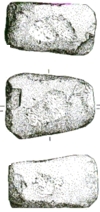

Craig y Mwyn Mine, Llanrhaeadr ym Mochnant, Berwyn Mountains, Montgomeryshire [SJ 074 285]
The history of this lead mine and the origins of the ancient opencast and spectacular hushing activity visible from the east side of the Rhayader Valley have long remained a mystery.
The mine was ancient when work re-
Recently the system of leats and hushing channels responsible for the working of
the opencast have been surveyed by the Clwyd-
In 2002 the EMRG sectioned one of the feeder leats associated with a hushing tank
believed to have been in use towards the end of this early period of activity, and
a date of around c.1350-

opencast with tanks and hush channels around its edge copyright RCAHM Wales
The implications of this earlier abandonment phase are that the last hushing and mining was carried out during the early medieval period – possibly linked to the mining interests of the Cistercian monks.
New evidence available from peat cores extracted from an area of blanket bog above the site now suggests that there was a still earlier phase of Roman exploitation of the lead veins.
![]()
![]()
This website was made possible by a grant from the Cambrian Archaeology Association

The style of working these massive opencasts through hushing is certainly reminiscent of Roman gold mining in NW Spain.


Section through leat feeder channel for later hushing.
Diagram showing metal peaks in core.
Medieval
Roman